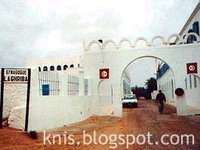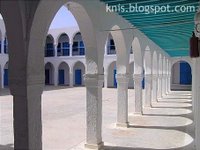

El-Ghriba significa "la maravillosa" en árabe, siendo llamada así la sinagoga debido a su particular belleza. Hay quienes dicen que en este lugar murió una hermosa joven que escapó de la destrucción del Bet HaMikdash, y de ahí el nombre del Bet HaKeneset.
Se cree también que fue construida por un grupo de Cohanim que dejaron Israel tras la destrucción de Ierushalaim a manos de los babilonios (de hecho, entre los judíos de Túnez hay un altísimo índice de Cohanim, mucho más que entre los judíos de otros países). Posiblemente, haya sido construido en el siglo I e.c., siendo una de las sinagogas más antiguas del mundo en constante uso desde entonces. No obstante, fue sometida a múltiples remodelaciones a lo largo del tiempo, como ocurrió en el siglo XVI luego de ser destruida en una invasión española. Su presente forma corresponde a una refacción de la decada del 20'.Durante la Segunda Guerra Mundial, Túnez fue enteramente ocupada por los nazis, quienes fijaron leyes antisemitas en el país. Tras su independencia, el gobierno también mantuvo varias políticas contra los judíos, aboliendo el Bet Din (Tribunal Rabínico) en 1957, y destruyendo varias propiedades de la comunidad.
Es una costumbre local que toda la comunidad visita esta sinagoga en Lag LaÓmer, en recuerdo de Ribí Shimón bar Iojai y Ribí Meír Baal HaNes. Hoy en día, esta fiesta es practicada también por judíos del exterior, oriundos principalmente de Israel y Francia, quienes visitan la sinagoga para esta época.
Actualmente residen en Túnez unos 1.500 judíos.
Outside view of the El-Ghriba synagogue, in Djerba, Tunisia.
El-Ghriba means "the wonderful one" in Arab, being called therefore the synagogue due to its particular beauty. There are some who say that in this place died a beautiful young girl who escaped of the destruction of the Beth HaMikdash, naming after her the Beth HaKeneset with this name. Also is believed that was built by a group of Cohanim that left Israel after the destruction of Ierushalaim at the hands of the Babylonians (in fact, between the Jews of Tunisia there is a highest index of Cohanim, much more which between the Jews of other countries). Possibly, has been built in the first century of our era, being one of the oldest synagogues of the world in constant use since then. However, it was put under multiple remodelings throughout the time, as it happened in 16th century after being destroyed in a Spanish invasion. Its present form corresponds to a rebuilt of the 20's. During World War II, Tunisia entirely was occupied by the Nazis, who fixed anti-semitic laws to the country. After his independence, the government also maintained several policies against the Jews, abolishing the Beth Din (Rabbinical Court) in 1957, and destroying several properties of the community. It is a local custom that all the community visits this synagogue in Lag LaOmer, in memory of Rabbi Shimon bar Iochay and Rabbi Meir Baal HaNes. Nowadays, this celebration is also practiced by Jews of the outside, native mainly of Israel and France, who visit the synagogue by this date. Today about 1,500 Jews reside in Tunisia.
No hay comentarios.:
Publicar un comentario